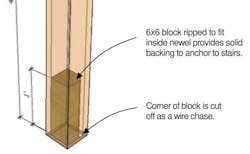Stair Trim-Out (2) — Building a Mitered Box Newel
The newel posts for this stairway are 4-foot-tall, 6x6-inch vertical grain boxes with mitered corners made from Douglas fir. A solid block in the bottom is for mounting the KeyLock hardware or for securing the newel posts to the treads and risers.
(This is the second in a series of articles about trimming a stairway in a 100-year-old cabin built using vertical logs.)
The only post that could not be pre-built on this stairway is the center one, which I wrapped in place with individual pieces of the mitered fir. A few of the pieces had to be scribed around the treads and risers.
The other newel posts started as four 48-inch-long pieces of 1x8. I ran the pieces through a planer to take the cupping out, which reduced the thickness to 5/8 inch. To get rid of any crook or wain, I ran one edge over a jointer and used that edge to ride against the table saw fence as I ripped the 45-degree angle.
Next, I set the table saw fence so that I could rip the pieces to 6-1/8 inches wide to the long points. The extra 1/8 inch allowed me to run the long miters over my jointer and still finish with a 6-inch box.
The jointed miters will ensure a tight glue joint.
Biscuits align the joint and lock faces together
Once jointed, I cut biscuit slots along the edges near the heel, or short point, of the miter. For this application, I placed the biscuits 6 inches apart, starting 3 inches from each end.
Next, I laid the 4 pieces side by side and applied glue to the biscuit slots and along the full length of the miters.
A solid block at the bottom expands anchoring options
Before this, I had cut a piece of 6x6 into one-foot lengths and ripped them to the inside dimension of the box newel.
These blocks were installed using polyurethane glue in the lower end of each newel. I ripped one of the corners of the block off to create a chase for low-voltage wiring for lighting.
Assemble with bar clamps, patience, and more bar clamps
After installing biscuits in all of the slots in two of the boards, I assembled the four pieces, making sure I had plenty of bar clamps on hand.
I applied just enough pressure to make the joints tight, and the long points of the miters meet. No, I didn't try to make the wood grain line up at the miters. It was just luck. Once dry, I took the clamps off, scraped off the excess glue, and sanded all four sides with 150-grit sandpaper on an orbital sander.
I pre-drilled a 5/16-inch hole in the center of each block to accommodate the lag bolt from the KeyLock hardware. I also eased the mitered corners with a 1/8-inch-radius router bit mounted in a laminate trimmer so that the corners would hold a finish. I hand-sanded that with a sanding sponge.
Now that these box newels are ready for the painter, I'll swap them for the finished skirt stock and get to work installing those.
